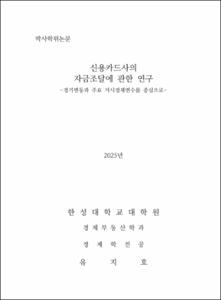신용카드사의 자금조달에 관한 연구 관한 연구
= A Study on the Funding Structure of Korean Credit Card Companies : Focused on the Business Cycles and Main Macroeconomic Variables
- Type
- Thesis
- Alternative Title
- 경기변동과 주요 거시경제변수를 중심으로
- Department
- 대학원 경제부동산학과
- Issued Date
- 2025
- Publisher
- 한성대학교 대학원
- Files in This Item:
-
-
Download
 200000852949.pdf
기타 데이터 / 4.94 MB / Adobe PDF
200000852949.pdf
기타 데이터 / 4.94 MB / Adobe PDF
-
Items in Repository are protected by copyright, with all rights reserved, unless otherwise indicated.